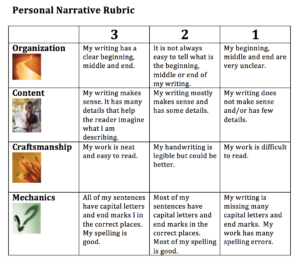Writing Skill Focus: Personal Narrative
Objectives: Students will write narratives in which they recount a well-elaborated event or short sequence of events that took place in their lives
Art Forms:
Photography

Sculpture

Vocabulary
Recall/ remember – to bring back from memory
Discover – to see, get knowledge of, learn of, find or find out
Compose – to make or form by combining thing, parts or elements
Language for Writing Personal Narratives
I remember ________________.
This was important to me because ___________.
I felt __________________ (emotion) because __________.
Introduction Activity
Step 1: Show a variety (at least 4) of photographs that visually represent a personal story of a person. Include your own photos, and ones from different times and cultures and even pictures of the class on a field trip etc.
Step 2: Begin Talking about the Photographs
(Artful Thinking)
What do you see?
What do you think?
What does it make you wonder?
Step 3: Sensory Language Exercise
Create 4 sensory stations – Introduce/Review the 5 Senses (explain that we already worked on sight, while looking at the photos)
Sound – audio file
Taste – candy, crackers etc
Touch – bubble wrap, scarves, little toys, sandpaper
Smell – perfumes, orange, oils
In small groups, students should quickly go to each station.
After they have rotated through all the stations come back as a large group to talk about what they listened to, tasted, touched & smelled
Look at the photographs again and think about what senses they might have experienced in those photos
Thinking Routines (Recall, Discover, Compose)
Recall/Remember
Recall one moment from your life that you would like to write about (seed story)
1.Draw a picture of this moment.
2. Interview a partner about this moment by asking the following questions:
– What do you remember most about this moment?
– Why do you want to write about this moment?
Discover
Have students discover the specific details of what made that moment special
| People | Place | Activity/Actions | |
| Sight | |||
| Sound | |||
| Smell | |||
| Touch | |||
| Taste | |||
| Emotions |
Have students create “sensory sentences” using their “discovery” chart. Write each sentence on a separate piece slip of paper. Make all the necessary revisions and edits.
Compose
Using a graphic organizer students should begin the composition process by sequencing the events of the moment they are writing about.
Decide in which part of the story the different “sensory sentences” will appear.
*If teachers follow a writer’s workshop format, they should continue the drafting, revising and editing process as normal at this point. For beginning level ELL students teachers can stop at the composing step.
SCULPTURE
1.Show students examples of sculpture, including a paper mache sculpture, which they will be making using recycled material:
 2. Ask students to think about their personal narrative and what they would want to create for the sculpture that will show their (the students’ sculptures do not have to be a person, they could also be an object or location)
2. Ask students to think about their personal narrative and what they would want to create for the sculpture that will show their (the students’ sculptures do not have to be a person, they could also be an object or location)
3. Begin to create sculptures using recycled materials and tape. Once sculpture is done they should be covered with newspaper and painted.
4. Presentation
Display sculptures around the classroom or on one table. Have each student read their personal narrative and then present their sculpture:
My sculpture is ________________. I chose this __________ because _____________________________________
Backward Looking
a.Have you done a similar kind of work in the past (earlier grades etc)?
b.Have you made something like this before?
a.What problems did you encounter while you were working on this piece? How did you solve them?
b. What was difficult for you when making _______________?
Inward Looking
a. What was especially satisfying to you about either the process of the finished product?
b. What did you like the most, working on your piece or when it was finished?
a. What did you learn about yourself as you worked on this piece?
b. When working on this project did you like reading, writing, discussing or creating?
Outward Looking
a. What is the one thing you want people to notice when they look at your piece?b. What do think others like the best about your project?
a. In what ways did your piece meet the objectives?
b. Did your piece meet the objective: ____________________________?
Forward Looking
a. What is one thing that you have seen in your classmates’ work or process that you would have liked to try?
b. What do you like about your classmates projects?
a. & b. One thing you would like to improve?

